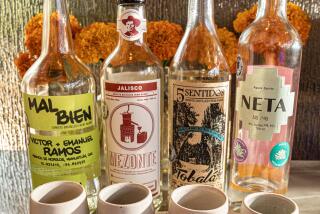Going for the Gold : Aggressive Cuervo Adds Satellites, Pushes for Olympics Team, Considers Bonds Sale
- Share via
TEQUILA, Mexico — Grupo Cuervo is betting that a mix of agricultural techniques pioneered by the Aztecs and satellite technology will ensure its future as Mexico’s biggest tequila maker.
The 200-year-old company--which uses centuries-old techniques to cultivate and harvest agaves, the cactuslike plant from which tequila is extracted--has added a twist of modern technology to tequila making.
The company now uses satellites to count how many agave plants are being cultivated in the arid tequila region some 370 miles west of Mexico City and how many are ripe for production.
Cuervo executives figured that “if the U.S. could count Saddam Hussein’s Scud missiles during the Gulf War, why couldn’t we know how many agave plants were there in the fields?” said Ricardo Tellez, Cuervo’s chief executive officer.
That’s a crucial number because it takes seven to eight years for an agave plant to mature. Cuervo hopes that by keeping careful track of the crop, it can ensure there’s always plenty of raw material on hand.
“If we see a shortage, we can plant our own agaves according to our consumption forecasts,” Tellez said.
The company’s agile management, coupled with robust exports, has helped Cuervo weather Mexico’s deep recession. Three quarters of the 4.5 million cases of Cuervo tequila produced last year were shipped abroad, with the U.S. accounting for 2.7 million, almost triple the 1 million cases the company sold in Mexico.
To keep the exports flowing, Cuervo plans to spend $25 million and $35 million on marketing this year. The company, which produces 100,000 liters a day of tequila at two distilleries in the state of Jalisco, had sales of about $200 million last year. The family-controlled company declined to release earnings figures.
The company’s marketing efforts can be pretty splashy.
In 1995, Cuervo leased an 8-acre island in the Caribbean which it promptly dubbed the “Republic of Cuervo Gold.” The company plans to petition the United Nations for a seat as the 192nd member of the General Assembly, as well as for permission to enter a beach volleyball team in the Atlanta Olympic Games.
“We want people to associate Cuervo with having a good time,” Tellez said. “Cuervo should be like Nike shoes, it should be a lifestyle.”
The ad campaign is the brainchild of Cuervo’s partner, International Distillers and Vintners, the liquor unit of Britain’s Grand Metropolitan Plc. Seven years ago, descendants of the founding Cuervo family sold a 45% stake to IDV.
The relationship has enabled Cuervo to adopt modern marketing techniques, such as developing products aimed specifically at the big U.S. market for margaritas.
“We’ve tried to have as many types of tequila to satisfy the broad range of consumers,” Tellez said.
*
Cuervo’s not satisfied with just selling tequila to taco-noshing U.S. yuppies. It wants to persuade Americans to drink the stuff straight, the way it’s consumed at home.
To that end, it has introduced Reserva de la Familia, a special, 3-year-old tequila that sports a smoother taste. Cuervo is marketing the premium-priced product as a digestif.
“What we are telling people is ‘Don’t serve Reserva in a shot glass, but a brandy snifter,’ ” said Steve Goldstein, marketing director at Heublein Inc., IDV’s U.S. distiller.
Investors who would like to place a bet on Cuervo’s future may soon get a chance. To pay for its expansion plans, the company is considering selling as much as $50 million in bonds to global investors.
The company has hired J.P. Morgan & Co. Inc. to gauge demand among institutional investors for a medium-term bond. The securities are expected to be backed by the proceeds of sales of tequila abroad. That should reduce the interest rate the company needs to pay to borrow.
Some of the money would be used to develop cloning techniques for Cuervo’s agave plants. Through biotechnology the company hopes to reduce the number of years it takes an agave to mature, officials said.
More to Read
Sign up for Essential California
The most important California stories and recommendations in your inbox every morning.
You may occasionally receive promotional content from the Los Angeles Times.










